Kamāl ud-Dīn Behzād
Kamāl ud-Dīn Behzād (c. 1450 – c. 1535), also known as Kamal al-din Bihzad or Kamaleddin Behzad (Persian: کمالالدین بهزاد), was a Persian painter and head of the royal ateliers in Herat and Tabriz during the late Timurid and early Safavid Persian periods.[1] He is regarded as marking the highpoint of the great tradition of Islamic miniature painting.[2] He was very prominent in his role as a director of a workshop in the Herat Academy as well as his position in the Royal Library in the city of Herat. His art is unique in that it includes the common geometric attributes of Persian painting, while also inserting his own style, such as vast empty spaces to which the subject of the painting dances around. His art includes masterful use of value and individuality of character, with one of his most famous pieces being "The Seduction of Yusuf”' from Sa'di's Bustan of 1488.[3][4][5][6] Behzād’s fame and renown in his lifetime inspired many during, and after, his life to copy his style and works due to the wide praise they received.[4][1][7] Due to the great number of copies and difficulty with tracing origin of works, there is a large amount of contemporary work into proper attribution.[1]
Kamāl ud-Dīn Behzād | |
|---|---|
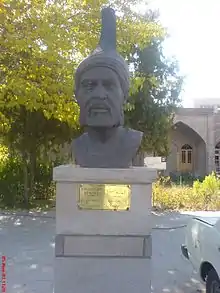 | |
| Born | 1455 |
| Died | 1535 (aged 85) |
| Occupation | painter |
| Era | Medieval Period, Late Timurid, Early Safavid Empire |
Notable work | Painting photographs of Jami, Sultan Husayn Mirza Bayqara, Ali-Shir Nava'i, Ismail I |
Biography
Behzād’s full name is Ustād Kamāluddīn Be[i]hzād.[8] His exact year of birth is unknown, and according to different sources, it varies from 1455 to 1460.[9][10] He was born and lived most of his life in Herat, a city in modern-day western Afghanistan and an important center of trade and the Timurid Empire's cultural and economic capital.[11]
Not much is known on Behzad’s childhood, but according to the author Qadi Ahmad, Behzād was orphaned at an early age and raised by the prominent painter and calligrapher Mirak Naqqash, a director of the Timurid royal library.[12][13][14]
Behzād was also a protégé of Mir Ali Shir Nava'i, a vizier, poet, and humanist, and the in the court of Herat during the reign of Timurid sultan Husayn Bayqarah (ruled 1469–1506).[15]
In several manuscripts issued in the 1480s in the Sultan Hussein Bayqarah's kitabhana (workshop), Behzad's participation is seen, which evidences his work in the court in the period.[16] In 1486, with a decree of Sultan Hussein Baykar, Behzad was appointed head of the royal ateliers in Herat and succeeded Mirak Naqqash. Under his leadership, the academy reached its greatest period.[17]
In 1506, Sultan Hussein Bayqarah died, and a month after his death, Herat was captured by the troops of the Bukhara Khanate, led by Mohammed Sheibani Khan. Some researchers believe that between 1507 and 1510, Behzadin was in Bukhara, following Sheibani Khan with other artists from Herat (although Babur reports that he was in Herat during those years).[16]
Behzad's fame reached its zenith during this period. A fable states that during the Battle of Chaldiran in 1514, in which the Ottoman Turks defeated the Persian army, Shah Ismail I hid Behzad in a cave as a treasure.[18]
In 1522, Behzād was employed by Shah Ismail I Safavi in Tabriz (the capital of the new Safavid Empire), where, as director of the royal atelier, he had a decisive impact on the development of later Safavid painting.[16] According to Muhammad Khwandamir, Shah Ismail I employed Behzad with a decree in which he described the painter as “...[a] miracle of our century, a model for painters and an example for goldsmiths, master Kemal-od-Din Behzad, who with his brush shamed Mani and humiliated the pages of Arzhang with his draftsman's pencil ..."[19]
In 1524, Shah Ismail suddenly died. Behzad's later work is usually associated with the name of Shah Ismail's son, Shah Tahmasp I (ruled 1524-1576).[20] Behzad continued to serve in the Shah’s workshop until his death in1535.[21]
Behzad’s tomb is located in Herat, beneath Kôh-i Mukhtâr (“Chosen Hill”).[22]
Career and style
Behzad is the most famous of Persian miniature painters, though he is more accurately understood as the director of a workshop (or kitabkhāna) producing manuscript illuminations in a style he conceived.[23][24][25] In 1486, Behzad became the head of the Herat Academy under the support of ruler Ḥusayn Bayqarah. He left that position in 1506, at the end of Bayqarah’s reign.[3] In 1522, Behzad moved to the city of Tabriz, following the Tahmasp, son of Shāh Esmāʿīl I, who had been named governor of Herat in 1514. It was in this city where he became the head of the Safavid royal library. He worked there until his death in around 1536.[4][8][6]
Persian painting of the period frequently uses an arrangement of geometric architectural elements as the structural or compositional context in which the figures are arranged.
Behzad is equally skilled with the organic areas of landscape, but where he uses the traditional geometric style Behzad stretches that compositional device in a couple ways. One is that he often uses open, unpatterned empty areas around which action moves. Also he pins his compositions to a mastery at moving the eye of the observer around the picture plane in a quirky organic flow. The gestures of figures and objects are not only uniquely natural, expressive and active, they are arranged to keep moving the eye throughout the picture plane.
He uses value (dark-light contrast) more emphatically, and skillfully than other medieval miniaturists. Another quality common to his work is narrative playfulness: the almost hidden eye and partial face of Bahram as he peers out the blinds to watch the frolicking girls in the pool below, the upright goat that looks like a demon along the edge of the horizon in a story about an old woman confronting the sins of Sanjar, the amazing cosmopolitan variety of humans working on the wall in the sample image.
This surprising individuality of character and narrative creativity are some qualities that distinguish Bezhad's works and that match their literary intent. Behzad also uses Sufi symbolism and symbolic colour to convey meaning. He introduced greater naturalism to Persian painting, particularly in the depiction of more individualised figures and the use of realistic gestures and expressions.
Behzad's most famous works include "The Seduction of Yusuf" from Sa'di's Bustan of 1488, and paintings from the British Library's Nizami manuscript of 1494-95 - particularly scenes from Layla and Majnun and the Haft Paykar (see accompanying image). The attribution of specific paintings to Behzad himself is often problematic (and, many academics would now argue, unimportant),[23] but the majority of works commonly attributed to him date from 1488 to 1495.
Legacy
One of Behzād’s lasting influences stems from his proficient depiction of humans and other organic motifs, bringing new depths to his painting’s narratives and characters. Behzād’s human figures were less stiff in their stances and more dynamic in their movements, creating a greater sense of energy and emotions to the paintings.[1][3][4] Likewise, Behzād utilized a method of painting that relied upon geometric formulas and a flattening of the visual plane to present the whole narrative in one painting and ensure the viewer’s eyes would move across the entire painting.[1]
Behzād’s technical mastery was coupled by a keen artistic eye as he was able to create a visually complex but compelling scene.[3][4] The fluidity of Behzād’s compositions reflect his capacity to create a realistic scene by reducing it to the most important elements. It is not to say that Behzad created unrefined works, rather, what he did choose to include was masterfully rendered and ripe with emotion and a masterful control of the brush and color.[1][5]
Behzād’s reputation was well-founded within his own lifetime with nearby rulers, such as the Mughal emperors, being willing to pay large sums for his paintings further adding to his fame and legacy.[1][5][10] With such a prestigious Behzād came to be a central figure to the Herat school of painting, eventually becoming the head of the Herat academy in 1486 and leaving in 1506.[1] As the head of the Herat academy he held large influence over the students, influencing the styles and techniques of future generations of Persian painters. Behzād’s fame and artistic renown would inspire imitation or other artists to learn from his paintings as well as more formally Behzād had large authority over the production of manuscripts, and thus their appearance.[7]
Within contemporary times much of the scholarly focus has been upon ensuring correct attribution to Behzād as there are concerns that some previously attributed works may not be from Behzād. With certain works attribution can be relatively confident from properly dated and placed signatures, but others were attributed in the 16th century and only contain stylistic similarities to Behzād’s works. Thus, raising questions of whether some works are skillful imitations, or if they are genuine.[3][5][8]
Bihzad in literature
Bihzad is mentioned throughout Orhan Pamuk's novel, My Name is Red, in which a workshop of Ottoman miniaturists regards him as one of the greatest Persian miniaturists.
Gallery
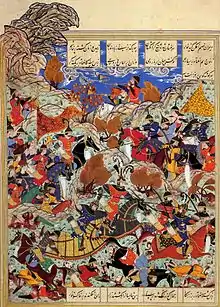
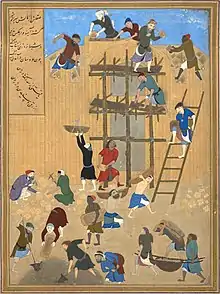
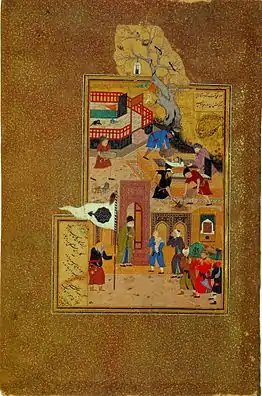 A miniature painting by Bihzad illustrating the funeral of the elderly Attar of Nishapur after he was held captive and killed by a Mongol invader.
A miniature painting by Bihzad illustrating the funeral of the elderly Attar of Nishapur after he was held captive and killed by a Mongol invader.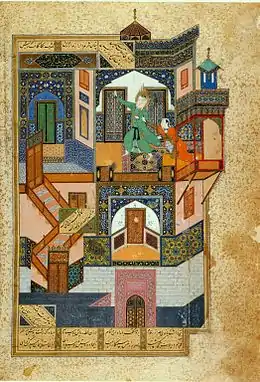 Yusef and Zuleykha
Yusef and Zuleykha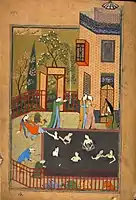 A miniature painting from the Iskandarnama
A miniature painting from the Iskandarnama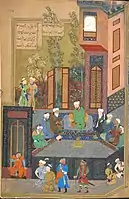 A miniature painting from the Iskandarnama
A miniature painting from the Iskandarnama The hunting ground.
The hunting ground.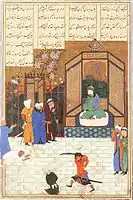 Beheading of a King
Beheading of a King Sultan Hussein
Sultan Hussein.jpg.webp) Timur granting audience on the occasion of his accession
Timur granting audience on the occasion of his accession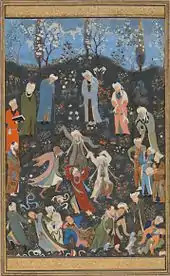 Dancing dervishes (c. 1480/1490)
Dancing dervishes (c. 1480/1490)
See also
| Wikimedia Commons has media related to Kamal-ud-din Bihzad. |
Notes
- The encyclopaedia of Islam, "Bihzād". Gibb, H. A. R. (Hamilton Alexander Rosskeen), 1895-1971., Bearman, P. J. (Peri J.) (New ed.). Leiden: Brill. 1960–2009. ISBN 90-04-16121-X. OCLC 399624.CS1 maint: others (link) CS1 maint: date format (link)
- Norwich, J.J. (1985–1993). Oxford illustrated encyclopedia. Judge, Harry George., Toyne, Anthony. Oxford [England]: Oxford University Press. p. 47. ISBN 0-19-869129-7. OCLC 11814265.CS1 maint: date format (link)
- "Herāt school". Britannica. Jul 20, 1998. Retrieved December 9, 2020.
- "Behzad". Britannica. March 30, 2016. Retrieved December 9, 2020.
- Barry, Michael A., 1948- (2004). Figurative art in medieval Islam and the riddle of Bihzâd of Herât (1465-1535). Bihzād, active 16th century. (English-language ed.). Paris. p. 153. ISBN 978-2-08-030421-6. OCLC 56653717.CS1 maint: multiple names: authors list (link)
- Balafrej, Lamia (2019). The making of the artist in late Timurid painting. Edinburgh. p. 204. ISBN 978-1-4744-3745-5. OCLC 1124796271.
- Rahmatullaeva, Sulhiniso (2014-11-02). "The Architecture of the Elementary School in Persianate Painting of the Fifteenth to Sixteenth Centuries". Iranian Studies. 47 (6): 871–901. doi:10.1080/00210862.2014.906225. ISSN 0021-0862. S2CID 161457080.
- Barry, Michael A. (2004). Figurative art in medieval Islam and the riddle of Bihzâd of Herât (1465-1535) (English-language ed.). Paris. p. 134. ISBN 978-2-08-030421-6. OCLC 56653717.
- Stierlin, Henri (2012). Persian art & architecture. Stierlin, Anne., Buchet, Adrien. London: Thames & Hudson. p. 144. ISBN 978-0-500-51642-3. OCLC 814179259.
- Oleg, Grabar (2000). Mostly miniatures: an introduction to Persian painting. Princeton, N.J.: Princeton University Press. p. 12. ISBN 0-691-04941-6. OCLC 43729058.
- Curatola, Giovanni (2007). The Art and Architecture of Persia. Scarcia, Gianroberto., Shore, Marguerite. (1st ed.). New York: Abbeville Press. p. 208. ISBN 978-0-7892-0920-7. OCLC 74029430.
- Aḥmad ibn Mīr Munshī, al-Ḥusainī, translated by Vladimir Minorsky (1959). Calligraphers and painters / a treatise by Qadi Ahmad, son of Mir-Munshi, circa A.H. 1015/A.D. 1606. Washington.CS1 maint: multiple names: authors list (link)
- Basil, Gray (1977). Persian painting. New York: Rizzoli. p. 115. ISBN 0-8478-0080-6. OCLC 3030835.
- Barry, Michael A. (2004). Figurative art in medieval Islam and the riddle of Bihzâd of Herât (1465-1535) (English-language ed.). Paris. p. 147. ISBN 978-2-08-030421-6. OCLC 56653717.
- Curatola, Giovanni (2007). The art and architecture of Persia. Scarcia, Gianroberto., Shore, Marguerite. (1st ed.). New York: Abbeville Press. p. 204. ISBN 978-0-7892-0920-7. OCLC 74029430.
- Soucek, Priscilla (1989). "BEHZĀD, KAMĀL-AL-DĪN". The Encyclopædia Iranica. Retrieved December 9, 2020.
- Stierlin, Henri (2012). Persian Art & Architecture. Stierlin, Anne., Buchet, Adrien. London: Thames & Hudson. p. 144. ISBN 978-0-500-51642-3. OCLC 814179259.
- Akimushkin, Oleg (2004). "The Legend of the Artist Behzad and Calligrapher Mahmoud Nishapuri" in the book "Medieval Iran. Culture, history, philology ". St. Petersburg. pp. 59–64. ISBN 5-02-027059-8.
- Soudavar, Abolala (1992). Art of the Persian courts : selections from the Art and History Trust Collection. Beach, Milo Cleveland., Art and History Trust Collection (Houston, Tex.). New York: Rizzoli. p. 95. ISBN 0-8478-1660-5. OCLC 26396207.
- Stierlin, Henri (2012). Persian Аrt & Аrchitecture. Stierlin, Anne., Buchet, Adrien. London: Thames & Hudson. p. 149. ISBN 978-0-500-51642-3. OCLC 814179259.
- Curatola, Giovanni (2007). The Аrt and Аrchitecture of Persia. Scarcia, Gianroberto., Shore, Marguerite. (1st ed.). New York: Abbeville Press. p. 210. ISBN 978-0-7892-0920-7. OCLC 74029430.
- Barry, Michael (2004). Figurative art in medieval Islam and the riddle of Bihzâd of Herât (1465-1535) (English-language ed.). Paris: Flammarion. p. 159. ISBN 978-2-08-030421-6. OCLC 56653717.
- Roxburgh, David J., “Kamal al-Din Bihzad and Authorship in Persianate Painting,” Muqarnas, Vol. XVII, 2000, pp. 119-146.
- Lentz, Thomas, “Changing Worlds: Bihzad and the New Painting,” Persian Masters: Five Centuries of Painting, ed., Sheila R. Canby, Bombay, 1990, pp. 39–54.
- Lentz, Thomas, and Lowry, Glenn D., Timur and the Princely Vision, Los Angeles, 1989.
References
- Balafrej, Lamia. The Making of the Artist in Late Timurid Painting, Edinburgh University Press, 2019, ISBN 9781474437431
- Brend, Barbara, Islamic Art, London, 1991.
- Chapman, Sarah, “Mathematics and Meaning in the Structure and Composition of Timurid Miniature Painting”, Persica, Vol. XIX, 2003, pp. 33–68.
- Grabar, Oleg, "Mostly Miniatures: An introduction to Persion Painting" Princeton, 2000
- Gray, Basil, Persian Painting, London, 1977.
- Hillenbrand, Robert, Islamic Art and Architecture, London, 1999.
- Lentz, Thomas, and Lowry, Glenn D., Timur and the Princely Vision, Los Angeles, 1989.
- Lentz, Thomas, “Changing Worlds: Bihzad and the New Painting,” Persian Masters: Five Centuries of Painting, ed., Sheila R. Canby, Bombay, 1990, pp. 39–54.
- Mehta, Suhaan. 2016. “Tradition and Tolerance.” Religion & the Arts 20 (3): 336–54. doi:10.1163/15685292-02003004.
- Milstein, Rachel, “Sufi Elements in Late Fifteenth Century Herat Painting”, Studies in Memory of Gaston Wiet, ed., M. Rosen-Ayalon, Jerusalem, 1977, pp. 357–70.
- Rice, David Talbot, Islamic Art, 2nd ed., London, 1975.
- Rice, David Talbot, Islamic Painting: a Survey, Edinburgh, 1971.
- Robinson, Basil W., Fifteenth Century Persian Painting: Problems and Issues, New York, 1991.
- Roxburgh, David J., “Kamal al-Din Bihzad and Authorship in Persianate Painting,” Muqarnas, Vol. XVII, 2000, pp. 119–146.